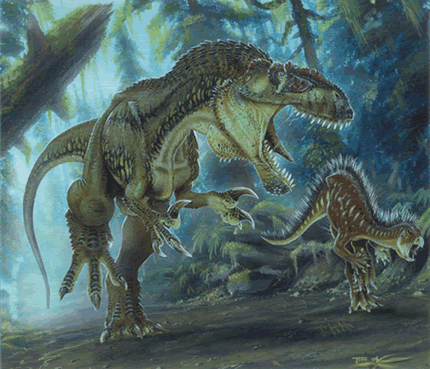Megalosaurus bucklandii- Carnivore Dinosaurs
Homepage > Carnivore Dinosaurs - Megalosaurus bucklandii
(MEG-uh-lo-SAWR-us) - "big lizard"
Describer --Ritgen, 1926
Also Known As --
Type of Species --bucklandii
Order Saurischia
SubOrder Theropoda
InfraOrder --
Micro-Order --
Family Megalosauridae
Size 26 feet (8meters) in length
Period Middle Jurassic and Early Cretaceous 181-169 million years ago
Fossilsite Forest Marble, Inferior Oolite, Chipping Norton Formation,
Gloucestershire; Stonefield Slate, Chipping Norton Formation, Oxfordshire;
Corallian Oolite Formation, NorthYorkshire; Forest Marble, Wiltshire;
Inferior Oolite, Northamptonshire; ?Wealden Beds, Bedfordshire, England;
Dep.de L'Indre, France
Diet Bipedal Carnivore

This is it, the very first dinosaur ever named. The word 'dinosaur' did not yet exist. In fact, this dinosaur was a typical two legged meat eater, but people back then knew so little about it that they thought it walked on four legs like a big lizard. It wasn't until 20 years later, in 1842, that Sir Richard Owen came up with the word 'dinosaur' to describe these spectacular fossil creatures which were being discovered.
Very little is known about this dinosaur despite its popular name and its association with the early scientific study of dinosaurs. The available evidence which relies largely on fossils of the jaws, teeth, and hip bones suggest that Megalosaurus was a massive carnivore. It has been estimated that the animal reached heights of 10 feet (3 meters), it grew to 30 feet (9 meters) long and weighed about 1 ton.

Reconstruction of Megalosaurus and Pterodactylus by Samuel Griswold Goodrich from Illustrated Natural History of the Animal Kingdom (New York: Derby & Jackson, 1859). This is typical of early reconstructions in presenting Megalosaurus as a quadruped, modern reconstructions make it bipedal, although no remnants of Megalosaurus's forelimbs have yet been found.
Its powerful hinged jaws and its curved, serrated teeth are suggestive that it was a strong predator that probably fed on a wide variety of animals, including large sauropods.
Discovery
William Buckland's description of Megalosaurus in the early 1820s was
the first formal description of a nonavian dinosaur. The description was
based on a collection of fossil fragments including parts of a leg, a
shoulder, a hip, and a jaw that gave scant clues to the appearance of
the living animal. Since then remnants of a wide variety of large theropods
includingTyrannosaurus and Allosaurus have been mistakenly identified
as belonging to Megalosaurus and there might still be misidentifications
waiting to be corrected.